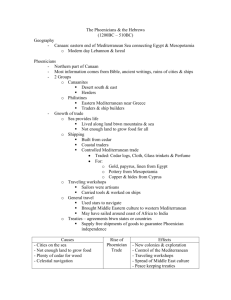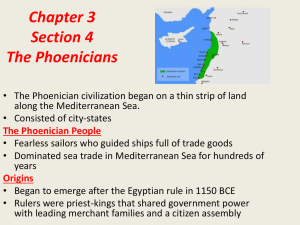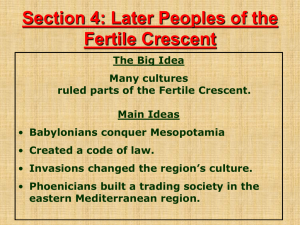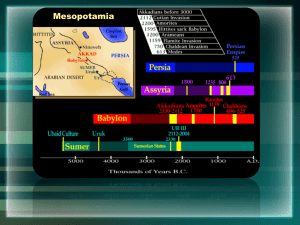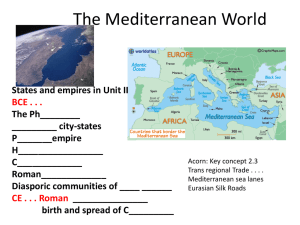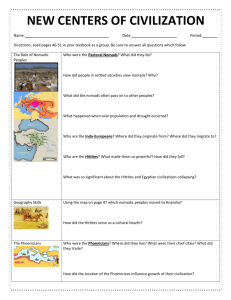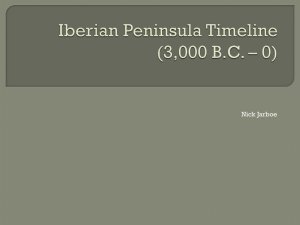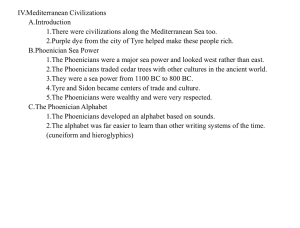Phoenician Alphabet
advertisement
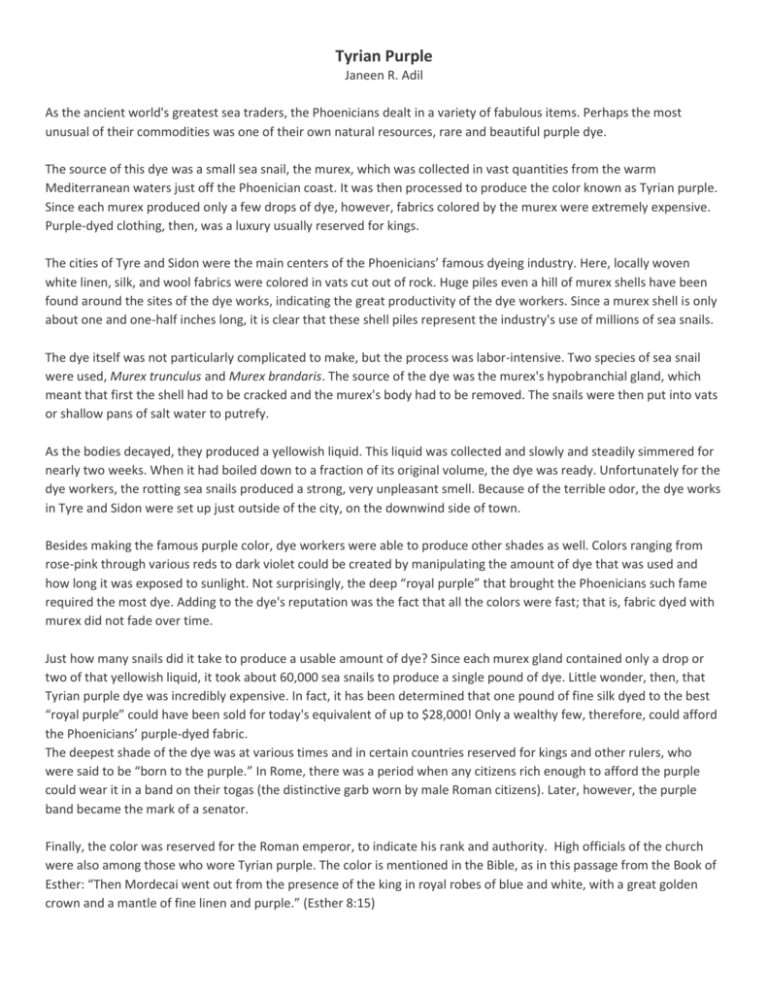
Tyrian Purple Janeen R. Adil As the ancient world's greatest sea traders, the Phoenicians dealt in a variety of fabulous items. Perhaps the most unusual of their commodities was one of their own natural resources, rare and beautiful purple dye. The source of this dye was a small sea snail, the murex, which was collected in vast quantities from the warm Mediterranean waters just off the Phoenician coast. It was then processed to produce the color known as Tyrian purple. Since each murex produced only a few drops of dye, however, fabrics colored by the murex were extremely expensive. Purple-dyed clothing, then, was a luxury usually reserved for kings. The cities of Tyre and Sidon were the main centers of the Phoenicians’ famous dyeing industry. Here, locally woven white linen, silk, and wool fabrics were colored in vats cut out of rock. Huge piles even a hill of murex shells have been found around the sites of the dye works, indicating the great productivity of the dye workers. Since a murex shell is only about one and one-half inches long, it is clear that these shell piles represent the industry's use of millions of sea snails. The dye itself was not particularly complicated to make, but the process was labor-intensive. Two species of sea snail were used, Murex trunculus and Murex brandaris. The source of the dye was the murex's hypobranchial gland, which meant that first the shell had to be cracked and the murex's body had to be removed. The snails were then put into vats or shallow pans of salt water to putrefy. As the bodies decayed, they produced a yellowish liquid. This liquid was collected and slowly and steadily simmered for nearly two weeks. When it had boiled down to a fraction of its original volume, the dye was ready. Unfortunately for the dye workers, the rotting sea snails produced a strong, very unpleasant smell. Because of the terrible odor, the dye works in Tyre and Sidon were set up just outside of the city, on the downwind side of town. Besides making the famous purple color, dye workers were able to produce other shades as well. Colors ranging from rose-pink through various reds to dark violet could be created by manipulating the amount of dye that was used and how long it was exposed to sunlight. Not surprisingly, the deep “royal purple” that brought the Phoenicians such fame required the most dye. Adding to the dye's reputation was the fact that all the colors were fast; that is, fabric dyed with murex did not fade over time. Just how many snails did it take to produce a usable amount of dye? Since each murex gland contained only a drop or two of that yellowish liquid, it took about 60,000 sea snails to produce a single pound of dye. Little wonder, then, that Tyrian purple dye was incredibly expensive. In fact, it has been determined that one pound of fine silk dyed to the best “royal purple” could have been sold for today's equivalent of up to $28,000! Only a wealthy few, therefore, could afford the Phoenicians’ purple-dyed fabric. The deepest shade of the dye was at various times and in certain countries reserved for kings and other rulers, who were said to be “born to the purple.” In Rome, there was a period when any citizens rich enough to afford the purple could wear it in a band on their togas (the distinctive garb worn by male Roman citizens). Later, however, the purple band became the mark of a senator. Finally, the color was reserved for the Roman emperor, to indicate his rank and authority. High officials of the church were also among those who wore Tyrian purple. The color is mentioned in the Bible, as in this passage from the Book of Esther: “Then Mordecai went out from the presence of the king in royal robes of blue and white, with a great golden crown and a mantle of fine linen and purple.” (Esther 8:15) So important to the Phoenicians was their dyeing industry that their earliest coins, struck in Tyre around the middle of the fifth century BCE, show a murex shell on one side. Some scholars suggest that even the name Phoenicia came from the Greek word for purple. Although the centers of the purple-dyeing industry were in Tyre and Sidon, other places, too, were producing murexdyed fabrics. The Phoenicians set up dye works throughout their lands, including some on the islands of Malta and Motya. As the sea traders expanded the Phoenician empire, they brought this industry with them. In western areas, shell heaps and rock vats in many towns including Dar Essafi in Tunisia show that the Phoenicians established dye works as they colonized the area. By 1000 BCE, Tyre and Sidon were recognized throughout the ancient world as producers of the highest-quality purpledyed cloth. Even when Tyre fell, the dyeing industry continued, despite many setbacks. Records show that Charlemagne, the king of the Holy Roman Empire, bought purple-dyed fabrics in A.D. 800. After that time, however, the process of murex dyeing began to disappear it was a victim of its own enormous cost. Phoenician Ships Marcia Brightman The Phoenicians were renowned for their skills as sailors and shipbuilders. By modern standards, Phoenician ships were very small they could be only as long as the tallest trees were tall. Even so, Phoenician merchant ships traded throughout the Mediterranean and beyond, to Spain and Britain. Some historians claim the Phoenicians even voyaged around the tip of Africa and across the Atlantic Ocean. The earliest Phoenician ships borrowed their design and structure from Egyptian ships. As early as 3000 BCE, Egyptians were traveling to Phoenicia to get timber, so the Phoenicians were familiar with Egyptian boats. These boats were constructed from a large number of short planks held together with pegs and dowels and strengthened by a long truss, or brace, that connected the bow and stern. But, they were flat-bottomed, and so were ill-suited to sea travel. During the same time, the Phoenicians were also trading with seafaring Greeks who navigated long, narrow, dugout canoes with high sides for extra cargo space. Eventually these Greek boats evolved into a more advanced kind of ship that was constructed with a long, rigid keel to which planks were attached to form sides. Keeled boats enabled sailors to hold a better course and to handle big waves without pitching sideways. By around 1000 BCE, pictures on Greek pottery and on personal seals depict ships with rounded hulls, turned up at both ends. These vessels had one mast, and ropes for raising and trimming a sail. The Phoenicians also learned from the Sea Peoples (groups of aggressive seafarers who invaded the lands of the Middle East and Egypt around the 13th century BCE) that rowers facing toward the stern, rather than toward the bow (as the Phoenicians had traditionally faced), propelled a ship faster. Three types of ships developed from the Phoenicians’ acquaintance with the ships of their seafaring neighbors. The cargo ship, or merchantman, was used for carrying goods to be traded. It was three to four times longer than it was wide, and ranged between 30 and 80 feet long. It used a large, rectangular sail. The single mast was set in a slot at the bottom of the ship, centered between the bow and the stern. Its round hull accommodated a large hold for carrying cargo. It was known as a “black ship” because its planks were covered with pitch to make it watertight. Propelled mainly by wind power, the merchantman was equipped with a few oars for maneuvering into and out of harbors and for making headway when the wind died down. Steering was accomplished with steering oars, which hung down from each side of the ship near the stern. (Rudders for steering were not used in the west for another 2,000 years.) The war galley was used to carry large numbers of fighting men for engaging in naval battles. Speed and maneuverability were crucial factors in being able to establish a desired position during a naval battle, so the galley was long and sleek, with a small sail and two banks of oars. Whether invented by the Phoenicians or by the Greeks, ships with two banks of oars, one slightly higher than the other, were called biremes. Eventually, by 500 BCE, the Phoenicians and Greeks were using triremes, or “three-bankers,” as their biggest warships. Oarsmen hung their shields over the low sides of the galley. They chose the low sides so that they could stand and shoot arrows or jump over the side to wade ashore. By about 1000 BCE, the Phoenicians either developed or began copying the idea of attaching a ram to the prow of a war galley. The ram was used to bash a hole in another vessel, leaving it helpless while archers picked off the stranded oarsmen and soldiers aboard. Another type of vessel was the myoparones, or “mussel boat,” which was a cross between the warship and the merchant ship. It was used to accompany a war fleet or to serve as an armed merchantman when traveling along routes frequented by pirates. It had a moderate number of oarsmen, but no sail. The cedars of Lebanon grew in groves on the edges of the mountains bordering Byblos. The Phoenicians used this cedar for shipbuilding and for trading with their neighbors. The Phoenicians were fortunate to have trees as natural resources. These resources, combined with their mastery of shipbuilding, enabled the Phoenicians to command the trade routes of the ancient Mediterranean. Phoenician Alphabet Robin Varnum Herodotus, the ancient Greek historian known as the “Father of History,” credits Phoenician seafarers with introducing the art of writing to Greece. According to Herodotus, the introduction of writing was a major technological advance. Without writing, Herodotus's own work as a historian would not have been possible. In a very real sense, history began with the invention of writing. The period before its invention is called “prehistory” (just before history). The Phoenicians introduced alphabetic writing not only to Greece but also to all the ancient Mediterranean world. The Phoenician alphabet is the ancestor of all present-day alphabets. The Phoenicians did not invent writing, however. They did not even invent alphabetic writing. The very first writing systems were pictographic. Such systems including Sumerian cuneiform, Egyptian hieroglyphs, and Chinese ideographs use pictures to represent objects. The problem with such systems is that they must use large numbers of pictographs. The Egyptian system, for example, included more than 700 hieroglyphs. Pictographic writing was thus hard to learn and cumbersome to use. Alphabetic writing is much easier to learn and use. Its invention became possible when someone recognized that graphic symbols could be used to represent speech sounds rather than objects. Since human beings produce only about 40 speech sounds, no more than 40 symbols are necessary for alphabetic writing. Most languages make do with fewer than 40. Archaeologists are not sure who first invented the alphabet, but they do know where and approximately when it first appeared. The earliest-known alphabetic inscriptions date from between 2000 and 1500 BCE and were found on the eastern coast of the Mediterranean, on the Sinai Peninsula and in the region occupied by the modern countries of Israel, Lebanon, and Syria. Inscriptions found in the ruins of the Phoenician city of Byblos are early, although not the very earliest, examples of alphabetic writing. The Phoenician alphabet spread from Byblos to other Phoenician cities and then to Greece, Italy, North Africa, France, and Spain, and to the islands of Cyprus, Crete, Malta, Sicily, and Sardinia. Wherever Phoenician merchant-sailors sold their goods, they made written records of their transactions. Their trading partners all around the Mediterranean soon learned to keep written records of their own. The Phoenician alphabet had 22 consonants, but no vowels. It was written from right to left, with no space between words. Aleph, the name of the first letter of the Phoenician alphabet, meant “ox head,” and bet, the name of the second letter, meant “house.” The Greeks borrowed these names for their first two letters and used them to form the word alphabetos, the word used to refer to the whole body of symbols. Our capital “A” is derived from the Phoenician aleph. If you turn our “A” to the side, you can see it looks like an ox head. In the bustling markets of the ancient Mediterranean, merchants traded oil, wine, and alphabets. Thus, by the end of the second millennium BCE, a writing system that originally had developed elsewhere, perhaps in Egypt, had reached the eastern coast of the Mediterranean. Because the peoples in this region spoke a variety of languages, each group had to make some adjustments to ensure that the alphabet they received from their neighbors met their needs. Most changes were minor, since the area's major languages shared a number of basic features. Phoenician, Aramaic, and Hebrew, for example, are very similar, and Hebrew was written with the consonant-only alphabets of both these languages in turn. But Greek is completely unrelated to these Semitic languages. The Phoenicians, who were known throughout the western Mediterranean world as skilled sailors and traders, definitely came into contact with the Greeks, another group of overseas traders. Greek merchants quickly recognized the advantages an alphabet brought their competitors. For example, a Phoenician trader in North Africa did not have to guess what his partners at home would like him to ship as return cargo. All he had to do was write and ask. Perhaps, thought the Greeks, they, too, could make use of this marvelous tool. Sea Traders Diana Childress A narrow strip of fertile coastland lies between the Lebanon Mountains and the eastern shores of the Mediterranean Sea. Small rivers cut the strip into valleys. In places, the mountains themselves march down to the sea, forming tall headlands on a rocky shore. About 5,000 years ago, a Semitic people known as Canaanites settled here. They began to make dyes from sea snails, pottery from river clays, and glass from beach sand. With bronze axes, they hewed the magnificent cedars, firs, pines, and cypresses that grew on the mountainsides, and they learned to build ships. Over land and by sea, they exported timber to treeless Egypt. Although the Canaanites shared a common language and religion, they never united into one nation. Instead, the mountains and rivers that divided their land, and thus kept the groups of people separate from one another, encouraged the development of independent city-states, among them Aradus, Byblos, Sidon, and Tyre. Each city, ruled by a king and a council of elders, stood proudly on cliffs overlooking the sea or on coastal islands surrounded by water. Walls provided additional defenses. Harbors sheltered their ships. As the cities flourished, they became dependent on trade. Not enough crops could grow on the narrow plains between the sea and the mountains to feed their large urban populations. Besides food, the cities imported raw materials for their burgeoning industries. Their artisans needed flax and wool to weave and dye; ivory to carve into combs or decorations for fine cedar furniture; and precious metals and gemstones to shape into ornate bowls, cups, and jewelry. During the 12th century B.C., a period of invasions and upheavals rocked western Asia. The turmoil cut off these seaside cities from the inland trade they depended on to survive. To find new sources of food and raw materials, as well as new markets for their finished goods, these coastal Canaanites took to the oceans. They became the intrepid sea traders we call the Phoenicians. Over several centuries, Phoenician city-states established trading posts and colonies all around the southern and western Mediterranean in Cyprus, North Africa, Malta, Sicily, Sardinia, and Spain and on the Atlantic coasts of Europe and Africa. Many settlements lay only a day's sail apart from each other. Others were a long voyage away from fellow settlements. The journey from Tyre to the colony of Gadir (today Cádiz, Spain) probably took three months. The colonies were sited on easily defended islands or seaside cliffs and featured temples erected to honor the patron god or goddess of the founding city. Nearby farms provided food. Copper, tin, lead, silver, and gold flowed into the colonies from inland mines. The most successful Phoenician colony was Carthage, on the North African coast. According to legend, this “New City” (which is what Carthage means) was founded in 814 B.C. by the daughter of the Tyrian king. Before long, this prosperous city began founding its own colonies in Sicily, and later built an empire in North Africa and Spain that challenged an expanding Rome. Since the late ninth century B.C., when Phoenician traders originally settled Carthage, the city had grown in strength and influence, and its merchants had traveled to the ends of the earth. But as the Romans extended their rule across southern Italy and the islands of the Mediterranean, Carthage felt threatened. It seemed only a matter of time before war would erupt between the two powers. As a boy, Hannibal had heard stories of Carthage's humiliating defeat by the Roman army. His father, Hamilcar Barca, the great Carthaginian leader who had commanded the troops in the First Punic War, had made the young Hannibal swear eternal hatred against the Romans. Hannibal never forgot this vow. He trained vigorously and gained fame as an expert horseman. In 221 B.C., when he was twenty-six, the army elected him commander in chief. According to historical accounts, Hannibal was different from most generals. He often dressed like a common soldier and preferred to sleep on the ground. The Roman historian Livy also noted that Hannibal was “the first to enter the battle and the last to leave.” In 218 B.C., Hannibal crossed the Alps and prepared to attack Rome, launching the Second Punic War. He felt ready to continue the work of his father and had planned a terrifying surprise for the Romans. As part of his army, he included nearly forty African elephants, each dressed in armor and trained to carry soldiers into battle. Although Rome had experienced soldiers, few had fought against elephants. Hannibal had special log rafts built to ferry the elephants across rivers. Elephant handlers, called mahouts, guided the huge beasts through snowy mountain passes and over glaciers. These harsh conditions caused many deaths of both elephants and soldiers. Even Hannibal suffered. Somewhere in the marshes of the Arno River, he lost an eye to infection. Hannibal's conquest of Italy seemed certain, but he had underestimated Rome. The great city refused to surrender. The general's troops ranged up and down the Italian peninsula for fifteen years but could not bring the war to an end. Meanwhile, Rome slowly rebuilt its armies. The Phoenicians also negotiated commercial treaties closer to home. In the tenth century B.C., King Ahiram I of Tyre formed an alliance with his neighbors, the Israelites. He sent cedar and workers to build King Solomon's temple in exchange for wheat and olive oil. Also, the two kings joined forces to send a fleet of Phoenician ships out on the Red Sea. From an unidentified land called Ophir (Somalia, perhaps, or India), the ships returned with gold, sandalwood, and precious stones. Over the next four centuries, Tyre became the greatest Phoenician city. The Hebrew prophet Ezekiel described Tyre in the sixth century B.C. as a “powerful city . . . powerful on the sea . . . merchant of the peoples on many coastlands.” Tyre's “great wealth and trade goods,” he wrote, “enriched the kings of the earth.” But powerful Mesopotamian kings envied Phoenician wealth and harbors. The Phoenician cities paid exorbitant tributes first to Assyria and later to Babylon in an effort to keep their political independence. By the fourth century B.C., however, the cities lacked the means to stave off conquest. The final blow to Phoenician civilization in the eastern Mediterranean came with the fall of Tyre to the Macedonian king Alexander the Great, in 332 B.C. The western colonies survived longer, until 146 B.C., when the Romans burned Carthage to the ground. Although defeated, the Phoenicians left lasting legacies. Their shipbuilding and navigational skills aided the Greeks and the Romans. Even more enduring was their phonetic writing, the basis for the alphabet we use today.
